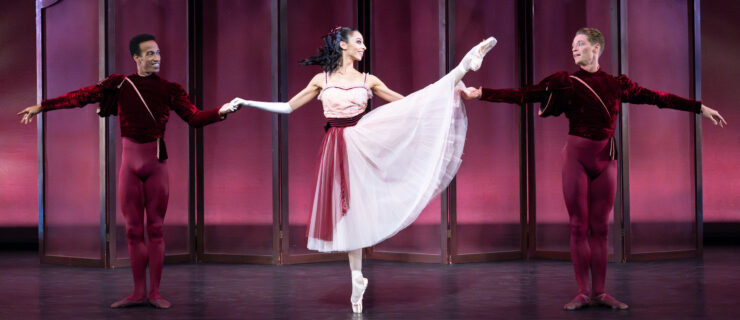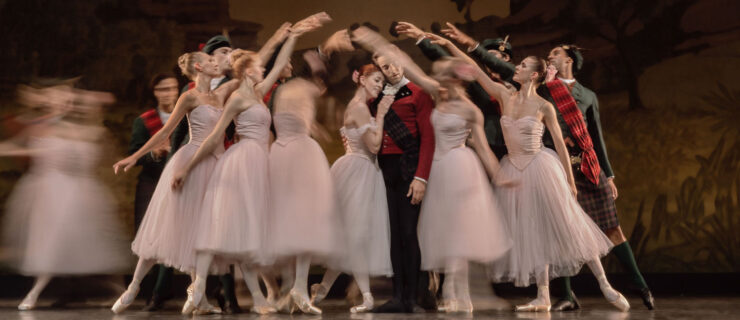Ask Amy: Curse of the What Ifs
Have a question?
Click here to send it to Suzanne Farrell Ballet dancer Amy Brandt.
How should I deal with pre-performance nerves? I try so hard to be confident, but I can’t stop thinking about all the “what ifs.” —Kasey
Nerves aren’t all bad—we need a few to give us that extra shot of adrenaline and keep us focused onstage. Trust me, I’ve made careless mistakes from feeling too complacent. But I’ve also given terrible performances due to paralyzing anxiety. And if you feel terrified, chances are the audience feels terrified for you.
Obsessing over potential disasters will only twist your stomach into larger knots. Sure, bad things happen—I’ve fallen on my face, forgotten choreography, lost a headpiece, improvised on the spot after an injured dancer crawled offstage. You just have to keep going.
You can’t control every aspect of a performance, but you can feel as prepared as possible. In rehearsals, don’t stop dancing if a step doesn’t go perfectly or the tempo seems a little off—you won’t be able to stop onstage, so practice adjusting. On performance days, give yourself plenty of time to properly warm up, fix your hair and makeup, and rosin your shoes—rushing will only increase your anxiety. Look for ways to relax: Listen to your favorite songs on your iPod, find a quiet space to meditate or chat up a friend who makes you laugh. Visualize a flawless performance instead of a disastrous one to help build your confidence.
When I put my weight between my first two toes on pointe, it feels like I’m winging. Can you roll over the inside corner of your box too much? —Hannah
If you feel like you’re winging on pointe, your weight is most likely not centered over the first two toes. Sometimes dancers intentionally push over the inside corner of their box to improve the line of their foot. But winging in a weight-bearing position can also signal weakness and cause a host of problems down the road. The excess pressure on your big toe and first metatarsal can aggravate bunion growth. And, according to North Carolina Dance Theatre’s physical therapist Angie Koonin, PT, ATC, you can also develop anterior impingement syndrome, a painful condition where tissues of the front, inner ankle are pinched between bones, causing them to swell and thicken.
Koonin recommends strengthening your ankles with a few simple exercises. First, in bare feet or slippers, face the barre in parallel and slowly practice prancing your feet through demi-pointe. “Try to keep your weight on all five toes and maintain a neutral foot position,” she says. Then, repeat in pointe shoes. She also recommends Thera-Band exercises in all four directions (pointing, flexing, winging out and sickling in), working each direction until your muscles begin to fatigue. And don’t forget your intrinsic muscles (those tiny muscles that move your toes). Try picking up marbles one by one with your toes and dropping them in a bowl.
Keep in mind that other factors, such as forced turnout or poor core strength, may also be contributing to your problem. And make sure your pointe shoes provide adequate support—boxes tend to warp as they break down. You can apply strong glue to the inside corner to help strengthen the box.
I feel bad sending all of my dead pointe shoes to a landfill. Is there any way to recycle them? —Connie
While retiring old pointe shoes feels wasteful, we do it for a reason—wearing dead shoes can be dangerous and bad for our feet. Currently there are no specific pointe shoe recycling programs. However, I did a little research with the Secondary Materials and Recycled Textiles Association, whose members acquire used clothing (including shoes!) for recycling purposes. According to SMART’s spokesperson, traditional pointe shoes—which contain natural and man-made materials like satin, cotton, jute and leather—can be recycled. Most likely the shoes will be sorted and broken down into their basic fiber components and manufactured into new products. To be sure, I took an old pair of mine to a textile recycling booth at my local farmers market, and they accepted them without a hitch. Check SMARTasn.org to see if there’s a textile recycling program near you.
Another option is to reuse your shoes creatively, or donate them to an artist. You’d be surprised by the number of crafty pointe shoe creations on websites like Etsy.com and Pinterest—check them out for inspiration or to find an artist who may want them.
However, don’t fret too much if you have to throw your old shoes in the trash. “Most pointe shoes are biodegradable and will break down under heat, moisture and pressure,” says Elissa McDonald, product specialist for Bloch Inc. “All of these elements combine in a well-developed compost situation and in most landfills.”





